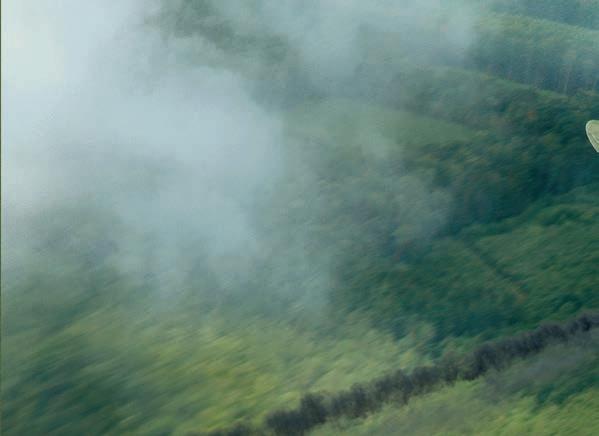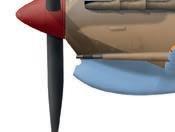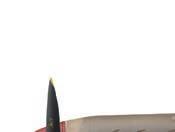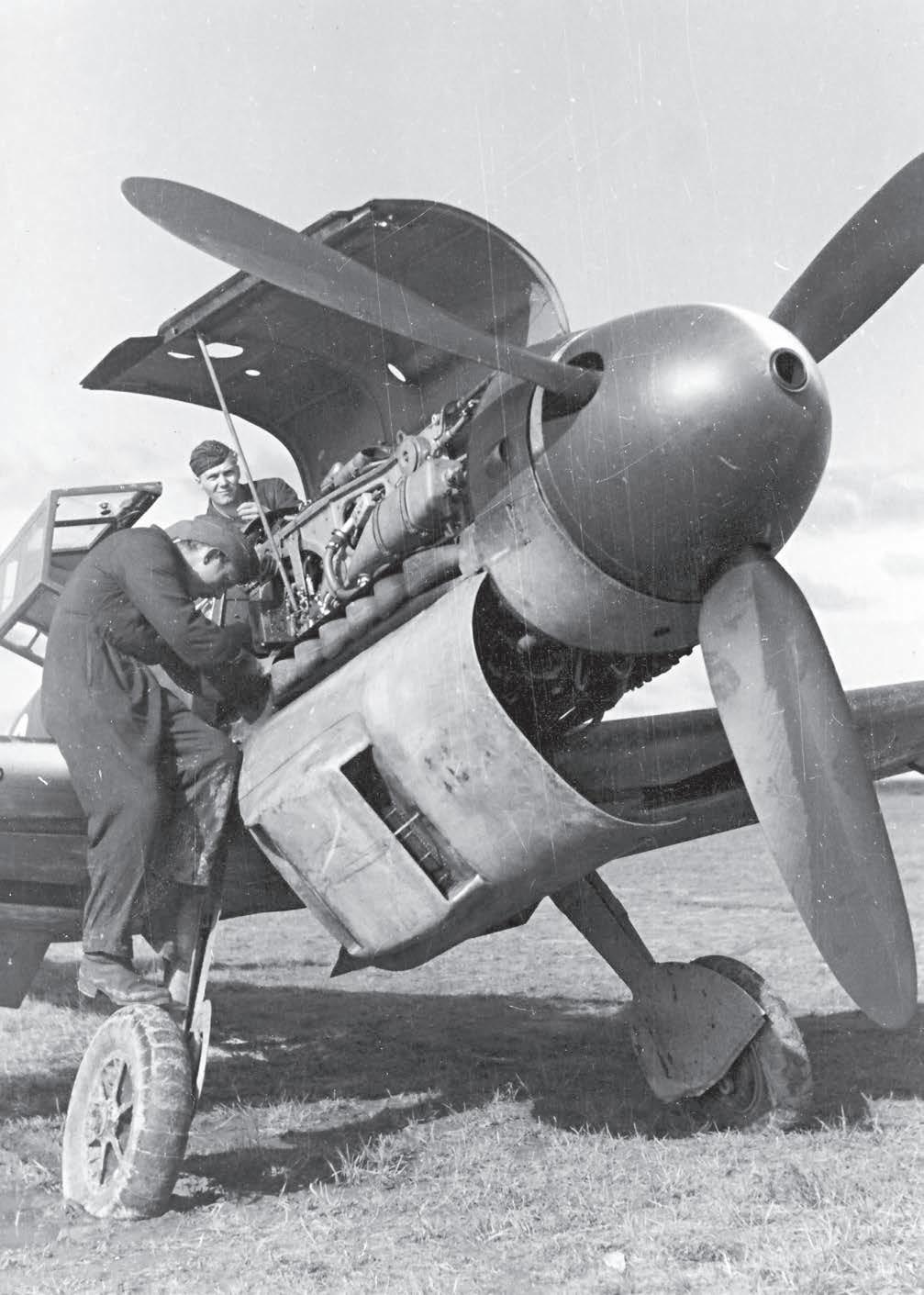
















296 pages, full colour, hardback book
MORE THAN 280 HIGHLY DETAILED FULL COLOUR AIRCRAFT DESIGNS














RAF Second World War Fighters in Profile features more than 280 highly detailed profiles of 15 di erent aircraft types flown by the Royal Air Force between 1939 and 1945. Full specifications and histories are included for British and Commonwealth fighters operated on all fronts during the conflict, from the iconic Supermarine Spitfire to US lend-lease types such as the Bell P-39 Airacobra and Curtiss P-40 Warhawk, and everything in between.
Written and illustrated throughout by renowned aviation artist Chris SandhamBailey, this book o ers exquisitely drawn profile views and scale plans of aircraft such as Hawker’s Hurricane, Typhoon and Tempest, plus the Westland Whirlwind, Boulton Paul Defiant and more. Covering all of the RAF’s high-performance wartime machines, this is indispensable reading for enthusiasts and modellers alike.
Author: Chris Sandham-Bailey

£35
Visit: www.mortonsbooks.co.uk Call: 01507 529529
Also on sale in major UK newsagents, plus other stores

Aviation enthusiasts have always been interested in the Luftwa e, in particular in the Messerschmitt Bf 109 and in the ghter aces that ew it. e focus always tends to be on the careers of the leading ghter pilots, the Jagd ieger Asse or Experten.
e Experten amassed incredible individual tallies of aerial victories. Some 90 Experten achieved more than 100 kills – the top 100 ghter aces in the history of aviation are all German.
Unfortunately, much of what is still being published is often not far away from wartime or even Cold War propaganda, with its emphasis on the leading aces and their ‘score’. However, some have started to see beyond the idealising approach of those writers who did so much to ‘popularise’ the exploits of the German ghter aces.
From a distance of 80 years, the number of claims led should no
longer be su cient reason to focus on this small group of pilots; it seems more appropriate to acknowledge the fact that all pilots, the old ‘hares’ like the young ‘newcomers’ (‘Nachwuchs’), had but one life to lose and that the unnamed or little-known Luftwa e pilots who perished in the war – more often than not in futile combat against the huge Allied bomber formations – deserve the same space in the history of the German ghter arm as do the so-called aces.
While some Luftwa e aces may have had tremendous individual successes – their achievements against weak and largely illprepared opponents trumpeted during the early years of victory –the Luftwa e as a whole proved largely unable to ful l its role as either a tactical or a strategic force for the greater part of the war.

Contrary to the myth, the Luftwa e was not a ‘mighty
force’ created from scratch virtually overnight. For the most part German ghter pilots were hopelessly outnumbered. Indeed the Jagdwa e – the ghter arm –never numbered more than 1500 serviceable single seat ghters. By mid-1944 its major opponents could easily eld ve times that number. As with much of the German war e ort, the surprising thing is not that the Luftwa e ghter arm failed but that it performed as well as it did for as long as it did. is publication thus takes a slightly di erent angle on the Luftwa e ‘ace’ pilots and their aircraft. Including many newly translated personal accounts, it details the individual experiences of some less well known Luftwa e pilots, Gruppen and Geschwader.
Neil Page
Author: Neil Page

Publisher: Steve O’Hara
Published by: Tempest Books, Media Centre, Morton Way, Horncastle, Lincolnshire LN9 6JR. Tel. 01507 529529
Typeset by: Burda Druck India Pvt. Ltd.
Printed by: William Gibbons and Sons, Wolverhampton
ISBN: 978-1-911639-71-8
© 2021 Mortons Media Group Ltd. All rights reserved. No part of this publication may be reproduced or transmitted in any form or by any means, electronic or mechanical, including photocopying, recording, or any information storage retrieval system without prior permission in writing from the publisher.

ank you to the following gentlemen for their invaluable help in compiling and illustrating this publication: JeanLouis Roba, Erik Mombeeck, Jean-Yves Lorant, Dr Jochen Prien, David E Brown, Philippe Saintes, Paul Stipdonk, Dr Hans Krensler and Kurt Braatz at 296 Verlag.
To the veterans; Ernst Schröder, Hans Weik, Karl-Heinz von den Steinen, Günther Ehrlich, Friedrich-Wilhelm ‘Timo’ Schenk, Jules Meimberg and Willi Unger. ank you. All personal accounts translated by Neil Page.

Neil Page has lived and worked in Germany and has a BA (Hons) degree in modern languages. An aviation enthusiast, he spent eight years at London Gatwick airport in ight dispatch with a major European airline. In addition to authoring the two volume Day Fighter Aces of the Luftwa e set, published by Casemate in 2020, he is a proli c blogger and aircraft modeller. His website, FalkeEins – the Luftwa e Blog, has garnered close to ve million page views over the past ten years.

“...The day was rounded off with a demonstration of captured American aircraft, in particular a P-51 Mustang – it was stressed that our Bf 109s and Fw 190s were generally superior to this type. We soon realised on our first combat sortie that this statement was not entirely accurate…”
Uffz. Kurt Scherer II./JG 4Feldwebel Fritz Gniffke – seen here on the left – with his Bf 109 G-6 coded ‘N Yellow 7’, in which he claimed a B-24 on April 11, 1944. Note that these 6./JG 302 Bf 109s, including ‘Yellow 11’ in the background, are displaying a II. Gruppe bar on a red fuselage band. The small ‘N’ signifies a machine used on night-time ‘Wilde Sau’ sorties. From December 1943 they would be increasingly deployed by day to counter US bombing raids until fully turned over to the day fighter role by May 1944.

With its small, light airframe designed around the most powerful engine then available, the Messerschmitt Bf 109 was one of the best and fastest ghter aircraft in the world in the period 19371941. Its superior ight performance virtually ensured air supremacy on all fronts. It was also a pretty unforgiving machine, with its small wing, narrow-track undercarriage, an overloaded airframe and large engine driving a broad-three-bladed
propeller. e 109 could be quite a handful even for an experienced pilot, especially on the ground.
Gunther Rall’s account of converting onto the Luftwa e’s standard ghter is revealing: “...its spindly narrow-track undercarriage is actually much too weak to cope with the enormous torque, rate of yaw, and turbulence of the airscrew. Take-o accidents are therefore commonplace, not just in the training schools, but also among front-line
units... And once in the air the pilot still has his hands more than full: the undercarriage must be retracted... before a certain airspeed is reached, engine and propeller have to be set manually to cruise, the aps cranked up by a large hand-wheel....and the now tail-heavy bird....trimmed for level ight..... [A few moments later].... frantically carrying out in reverse order everything that they had somehow successfully managed to do at take-o .
“It is advisable under such circumstances not to mix up, let alone forget, any of the actions described above, for the Messerschmitt is no docile carthorse, but a highly-strung thoroughbred. If the propeller pitch is not reduced in time, any attempt to go round again will end in a crash beyond the air eld perimeter. If the undercarriage has not been lowered, because the pilot has never before needed to lower an undercarriage in his life, he’ll at least get down on the eld, but in a resounding belly-landing. But even then the Messerschmitt still has a few more tricks up its sleeve. If the stick is not held rmly back after touchdown, or if the pilot stamps a little too heavily on the brakes, a ‘ground-loop’ or somersault is almost inevitable...”

Wolfgang Falck – the so-called ‘father’ of the Nachtjagd – was just one Luftwa e ghter ace who was of the opinion that one of the major ‘failures’ of the Luftwa e was in preferring the Bf 109 to the He 112. Falck’s 8. Sta el of the Jagdgeschwader Richthofen brie y ew the Heinkel in 1938.
“…the He 112 was an excellent aircraft... much easier for inexperienced pilots to y and with its low, wide track undercarriage far less prone to ground-looping... if the decision had been left up to the airmen then undoubtedly they would have preferred the He 112 over the Bf 109... Messerschmitt must have ‘lobbied’ hard or had far better contacts to the ‘upper echelons’...”
It may have also been the case that the He 112, when
tted with the uprated DB 605s (much increasing torque and wing loading due to heavy powerplant, armament and ammo, fuel and protection) would not have remained as docile as Falck recalled – although he was one of the few Luftwa e pilots to y the type in Luftwa e service.
Ultimately, Messerschmitt factory test pilot Dr-Ing Hermann Wurster, who both ew both types in the nal stages of the RLM ghter competition, lauded the Bf 109’s superior manoeuvring characteristics, in addition to highlighting the fact that it was lighter and faster as well as being easier and cheaper to manufacture. It is worth making the point that the Bf 109 was fast as a result of small low-drag wings and a ‘clean’ airframe. Later on in the war this
fact caused di culties of its own. Both Ernst Udet and Robert von Greim ew the Bf 109 to ‘test’ the new design in mock combat. Writing in Jägerblatt in 1966, Wurster concluded: “… e Bf 109 did not win the RLM ghter competition because of political lobbying or because Messers Milch and Lucht favoured the design.
e Messerschmitt was simply the better single-seat ghter…”
Bf 109 ‘Emil’
e Luftwa e was far from the ‘mighty’ force often imagined when Hitler invaded Poland during September 1939. Some ghter units were still equipped with the Jumo-engined Bf 109 D and others had only just been established with the E-1 and E-3. Both the Frenchown Curtiss H-75 and the MS 406 ghters (800hp engines) still held the edge over the Bf 109 Doras (700hp Jumo engine) they would soon meet in combat.
In one of the most celebrated encounters of the Phoney War, the Bf 109 D ghters of JGr. 102, led in the air by the leading Luftwa e ace at the time, Major Hannes Gentzen, ran into three ights of GC II/5 Curtiss H-75s.
e highly manoeuvrable Curtiss ghters secured a number of victories duly feted in the French media as the battle of the « 9 vs. the 27». From November 1939 the Luftwa e started to introduce the Emil variant of the Bf 109 with its DB 601 engine. e DB 601 represented a power increase of some 300hp over the Jumo of the earlier variants and had the advantage of fuel injection.
e Emil was clearly better in the air and immediately worried the French. e Emil can be considered the rst ‘mature’Bf 109 and although it was introduced only progressively.
e French ‘equivalent’ of the 109, the Dewoitine D.520, su ered considerable teething problems and achieved little during the so-called ‘campaign in the West’. While the DB 601 A enabled a considerable
increase in the performance of the Bf 109, the engine and its auxiliary equipment weighed some 400kg more than a Jumo 210, impacting the wing loading and making it that much trickier to pilot, especially on the ground.

It was fast – the E-7/N powered by the DB 601 N running on 100
octane C3 fuel could reach 570km/h.
e Bf 109 E-3 variant mounted 20mm cannon in the wings with 60-shell magazines which had no impact on performance in comparison to the MG 17 armed E-1 variant. If the Emil could be described as ‘kantig’ (angular) –being less ‘aerodynamic’ than the

Spit re Mk I – its design facilitated series production. More than 3500 examples were constructed between late 1938 and summer 1941.

During early 1941 the streamlined F-variant or ‘Friedrich’ was being progressively introduced – many of its pilots would cite it as the best Bf 109. Now, with the longer DB 601 E, takeo power was rated at some 1350hp with C3-96 octane fuel. e F-4/Z with its bigger oil cooler and GM-1 installation, e ective at heights above 8000m, was the rst purpose-built powerboosted variant. Ofw. Riedmier reported: “...During 1941-1942
I was an Oberfeldwebel in II./ JG 52 ying combat in Oblt. Steinho ’s 4. Sta el and scored
a number of victories. With the Friedrich we were masters of the skies in the East during this period. e ight characteristics of the machine were the best, you could roll the aircraft with the ailerons, without any need to use the rudder to steer.

“ e armament was excellent – two MGs mounted above the engine and one 20mm cannon ring through the spinner. If you were a decent shot, then the weight of re of both explosive and incendiary shells was more than su cient to wreak signi cant enough damage to bring an enemy aircraft down. We were by some distance superior to the Soviet pilots both technically and tactically during this period. ey paid a high price in blood but were quick learners.
“During May 1942 we were stationed at Zurichthal in the Crimea. On one particular sortie against incoming bomber formations I was hit by defensive re and a shell exploded against the port side of my cockpit canopy frame – splinters of metal and plexiglass penetrated in through my eye cavity and lodged behind my left eye. Despite serious injuries I managed to make an emergency landing on the eld.
“Our ight surgeon, a brave Swabian, was rst up onto the wing to examine the wound; ‘…desch Auge is hie... the eye has had it…’. No point beating about the bush; I had been blinded in my left eye. After my injuries healed I still wanted to y, although a combat posting was out of the question. at is how I found myself at Messerschmitt in Regensburg as an ‘Ein ieger’ – a factory test and delivery pilot.”
By July 1943, 25 Bf 109s were coming o the Messerschmitt Regensburg production lines daily – up from just one aircraft per day two years earlier and total monthly production of the Bf 109 reached a peak of some 900 examples. However, devastating air raids by the USAAF on the three main production centres during 1943/44 had a considerable impact on these numbers. Regensburg’s role in the production of the Bf 109 had been no secret to the Allies – for example a large number of 109s had been captured in North Africa and somewhat unbelievably all these

machines carried data plates with production/manufacturer details. Unsurprisingly MesserschmittRegensburg soon made its way to the top of USAAF’s target lists. e heavy raid of August 17, 1943, on Regensburg resulted in a production standstill that lasted some four weeks although the factory still managed 241 machines for the month.
Newer versions of the Bf 109 were under constant development as the war progressed in an e ort to maintain a competitive advantage over Allied ghters. e Bf 109 G-6 ‘Gustav’ was not particularly better than its predecessors but it was the most-produced version

and, crucially, the version that was developed to meet the Bf 109’s evolving role. Initially designed as an o ensive weapon to achieve superiority over the battle eld, the 109 became the ‘standard’ defensive Luftwa e ghter deployed to counter the Allied bombing o ensive. Even those 109s and their instrument-rated pilots employed at night were soon being dispatched against USAAF bomber formations raiding the Reich by day.

Feldwebel Fritz Gni ke of JG 302 reported: “.. on April 8, 1944, at around 12h15 – and somewhat to our consternation – we were put on 30-minute readiness. Few, if any of us, had had any combat experience by day. en at 13h00
the green are soared into the sky over the air eld – the signal for the 40 Messerschmitts of our Gruppe to get airborne! is on its own was an impressive spectacle, but then 20 minutes later we made visual contact with an armada of B-24 Liberators ploughing through the skies over Braunschweig.
“I can still recall closing in on and opening up at less than 100m distance on two of these lumbering machines, making no evasive manoeuvres whatsoever.
e starboard wing of one of the American bombers was a sheet of ame. I was unable to observe further as we soon found a gaggle of Mustangs on our tails and after some 30 minutes of wild turning and diving during the course of which I lost 4000m altitude I was able to give the American ghters the slip and landed at Ludwigslust bathed in sweat. We learnt that we had lost one of the best pilots in our Sta el during this encounter – Fw. Andreas Hartl was machinegunned by P-51s as he hung under his parachute.
“ e following day we were scrambled to intercept Liberators over Rügen... On April 11 we were just 20 Messerschmitts able to get airborne. e Schwarm I was leading managed to avoid the ghters and closed on a section of B-24s. Opening up at 150m with my cannon and two machine-guns I saw a series of explosions rip through the fuselage of the B-24 I was attacking. e res took hold in his wings and the huge machine started to go into a slow downward spiral. I shouted into the radio ‘Abschuss! Abschuss!’ My victim went down in ames near Bernburg – there were no parachutes. Once back on the ground my Bf 109 G-6 ‘Yellow 7’ showed no signs of having been in combat.
“On April 20 I ew a night sortie in the same ‘Yellow 7’ –ordered up at 23h20 to intercept a lone Mosquito over Berlin. I managed to catch sight of his contrails but he was too high and
too fast to leave me any chance of catching him – he must have been at an altitude of more than 9000m. It was the same scenario on May 3 – I felt quite powerless in my old Bf 109 G-6, since I needed at least an extra 50km/h turn of speed to catch a Mosquito!
“On May 13, I was scrambled against the Americans by day once again. e P-51s had soon split up our formation and I found myself again caught up in a dog ght, this time over Neubrandenburg. Everything happened so quickly. Several impacts shattered my canopy and slammed into my instrument panel – instinctively I threw my machine into a spin. Recovering some 2000m lower down I noticed that my ying suit was soaked in blood and I had no feeling in my right leg. Seconds later the engine juddered to a standstill. Luckily there were no Americans in the sector and I managed a wheels-up landing in a corn eld at Nienendorf… We were at a loss to understand how our commanders could send us up against P-51s...”
Galland’s ‘Kanonenboot’
Various solutions were tried out to increase the Messerchmitt’s performance and capability: more e cient engines of the AS type with power-boost or methanolwater injection giving increased speed for a short time were being worked on; increasing range by using drop tanks and increasing repower were further key considerations. e nose-mounted cannon was augmented from 20 to 30mm and the machine guns from 13 to 17mm. Rocket launchers and underwing MG 151 cannon installed in underwing trays –the R6 ‘modi cation kit’ – were developed on the insistence of the General of Fighters. All of these measures served to increase production times and complicate nal assembly.
Messerschmitt engineer Edmund Wrede reported: “I was employed as Gruppenleiter in the production


o ces at Regensburg and lled the role of Direktor Linder’s ‘Feuerwehr’ – his ‘ re-brigade’. In other words I intervened when di culties were encountered around the plant and in relations with sub-contractors. I recall that some time after he had been appointed General of Fighters, Galland visited Regensburg. He may well have been a highly decorated ghter ace but as a commander he had no leadership qualities whatsoever in my view. In the discussions we had – just as production of the Bf 109 G-6 was peaking – here was Galland suddenly insisting on augmented wing armament.
“I should point out that a 20mm MG 151 cannon and shells weighed some 70kg. He countered all our objections – increased weight, poor shot pattern due to vibrations, impact on production times and complexity of the installation with its additional cabling – by banging his st on the table and screaming, “I want cannon in the wings.” All of us – including Direktor Linder – just looked at each other in embarrassment and amusement at the same time. We had never experienced anything like it. If that’s what he wanted, well then, we’d just put the things on it. For Regensburg alone that meant 40 additional cannon per day, a huge
